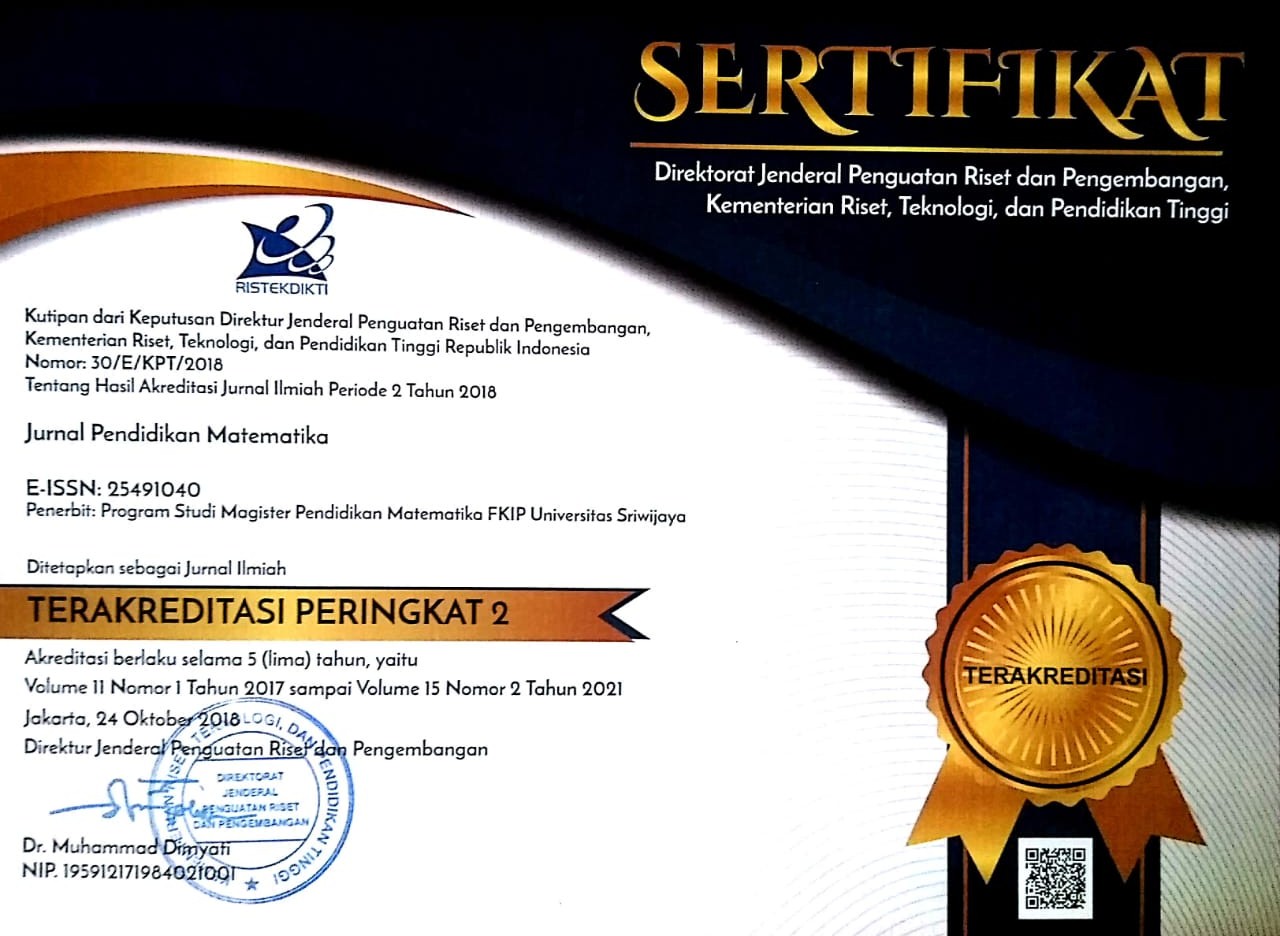Developing PISA-Like Math Tasks on Algebra Using Arabic Contexts
Abstract
This development research aimed to develop valid and practical PISA-like math tasks on algebra using Arabic contexts that potentially affect mathematical literacy skills. This research was comprised of two stages, preliminary and formative evaluations. This research employed the lesson study learning community (LSLC) system in the development and implementation process and involved grade eight students aged 13-15 years old in Junior High School 19 Palembang. Data collection techniques were walkthrough, observations, and interviews, while the analysis techniques were tests. This research produced six units and nine items of PISA-like-math problems with the content characteristics using Algebra topic, Arabic personal and social contexts, levels 2, 3, 5 and 6 following the 2018 PISA framework, process competencies at mathematical literacy skills, standard language application, applicability for students, and interpret by students. To conclude, the developed PISA-like math tasks were valid, provided practicality, and potentially affected on mathematical literacy skills, and learning to confront Arabic culture in South Sumatera.
Keywords
Full Text:
PDFReferences
Ahyan, S., Zulkardi, & Darmawijoyo. (2014). Developing mathematics problems based on PISA level of change and relationship content. IndoMS-JME, 5(1), 47-56. http://dx.doi.org/10.22342/jme.5.1.1448.47-56.
Akker, J. V. (1999). Principle And Methods of Development Research, In: J. Van den Akker, R. Branch, K. Gustafon, N. Nieveen & Tj. Plomp (Eds). Design Methodology and Development Research. Dordrect: Kluwer.
Bath, D., & Bourke, J. (2010). Getting started with blended learning. Queensland, Australia: Griffith Institute for Higher Education.
Dasaprawira, M. N., Zulkardi, & Susanti, E. (2019). Developing mathematics questions of PISA type using Bangka context. Journal on Mathematics Education, 10(2), 303-314. https://doi.org/10.22342/jme.10.2.5366.303-314.
Dewi, R., Putri, R. I. I., & Hartono, Y. (2018). Developing of interactive multimedia using PMRI on parallelogram [in Bahasa]. Jurnal Matematika Kreatif-Inovatif, 9(1), 78-83. http://dx.doi.org/10.15294/kreano.v9i1.14367.
Efriani, A., Putri, R. I. I., & Hapizah. (2019). Sailing context in PISA-like mathematics problems. Journal on Mathematics Education, 10(2), 265-276. https://doi.org/10.22342/jme.10.2.5245.265-276.
Ghozali, I. (2011). Multivariate analyze application with IBM SPSS 20,00 program [in Bahasa]. Semarang, Indonesia: Universitas Diponegoro.
Gravemeijer, K. (1994). Educational development and developmental research in mathematics education. Journal for Research in Mathematics Education, 25(5), 443-471. https://doi.org/10.2307/749485.
Jannah, R. D., Putri, R. I. I., & Zulkardi. (2019). Soft tennis and volleyball contexts in Asian Games for PISA-like mathematics problems. Journal on Mathematics Education, 10(1), 157-170. https://doi.org/10.22342/jme.10.1.5248.157-170.
Laal, M., & Ghosdi, S. M. (2012). Benefits of collaborative learning. Procedia – Social and Behavioral Sciences, 31(2012), 486-490. https://doi.org/10.1016/j.sbspro.2011.12.091.
Maharani, L., Putri, R. I. I., & Hartono, Y. (2019). Aquatic in Asian Games: Context of PISA-like mathematics problem. Journal on Mathematics Education, 10(3), 459-470. https://doi.org/10.22342/jme.10.3.5252.459-470.
MoEC. (2020). Circular Letter Number 4 of 2020 About the Implementation of Educational Policies in The Emergency Period for the Spread of Coronavirus Disease (COVID-19) [in Bahasa]. Jakarta: Minister of Education and Culture.
Murtiyasa, B., Rejeki, S., & Setyaningsih, R. (2018). PISA-like problems using Indonesian contexts. Journal of Physics Conference Series, 1040(1), 012032. https://doi.org/10.1088/1742-6596/1040/1/012032.
Nizar, H., Putri, R. I. I., & Zulkardi. (2018). Developing PISA-like mathematics problems using the 2018 Asian Games football and table tennis contexts. Journal on Mathematics Education, 9(2), 183-194. https://doi.org/10.22342/jme.9.2.5246.183-194.
Nusantara, D. S., Zulkardi, & Putri, R. I. I. (2020a). Designing PISA-like mathematics problem in COVID-19 pandemic (PISAComat). Journal of Physics Conference Series, 1657(1), 012057. https://doi.org/10.1088/1742-6596/1657/1/012057.
Nusantara, D. S., Zulkardi, & Putri, R. I. I. (2020b). Designing PISA-like mathematics problem relating change and relationship using physical distancing context. Journal of Physics Conference Series, 1663(1), 012004. https://doi.org/10.1088/1742-6596/1663/1/012004.
Nusantara, D. S., Zulkardi, & Putri, R. I. I. (2021). Designing PISA-like mathematics task using a COVID-19 context (PISAComat). Journal on Mathematics Education, 12(2), 349-364. http://doi.org/10.22342/jme.12.2.13181.349-364.
OECD. (2019a). PISA 2018 assessment and analytical framework. Paris: OECD Publishing. https://doi.org/10.1787/b25efab8-en.
OECD. (2019b). PISA 2018 results (Volume I): What students know and can do, PISA. Paris: OECD Publishing. https://doi.org/10.1787/5f07c754-en.
Octriana, I., Putri, R. I. I., & Nurjannah. (2019). Students’ mathematical reasoning in number of pattern learning using PMRI and LSLC [in Bahasa]. Jurnal Pendidikan Matematika, 13(2), 131-142. https://doi.org/10.22342/jpm.13.2.6714.131-142.
Putri, R. I. I., & Zulkardi. (2020). Designing PISA-like mathematics task using Asian Games context. Journal on Mathematics Education, 11(1), 135-144. http://dx.doi.org/10.22342/jme.11.1.9786.135-144.
Saputri, N. W. & Zulkardi. (2020). Developing students’ worksheet of mathematical modelling for junior high school students using online motorcycle-taxi [in Bahasa]. Jurnal Pendidikan Matematika, 14(1), 1-14. https://doi.org/10.22342/jpm.14.1.6825.1-14.
Sato, M. (2014). Conversation and collaboration in junior high school: Practice of learning community [in Bahasa]. Jakarta : JICA.
Simalango, M. M., Darmawijoyo, & Aisyah, N. (2018). Students’ difficulties in solving PISA tasks on change and relationship context at level 4, 5 and 6 at junior high school number 01 Indralaya [in Bahasa]. Jurnal Pendidikan Matematika, 12(1), 43-58. https://doi.org/10.22342/jpm.12.1.4246.43-58.
Stoerger, S. (2008). Book review – collaborative learning: Two perspective on theory and practice. International Review of Research in Open and Distance Learning, 9(2), 1-5. https://doi.org/10.19173/irrodl.v9i2.497.
Tessmer, M. (1993). Planning and conducting formative evaluation: Improving the quality of education and training. London, Philadelphia, PA: Kogan Page. https://doi.org/10.4324/9780203061978.
van den Heuval-Panhuizen, M., & Drijvers, P. (2014). Realistic mathematics education. In Lerman, S. (Ed.), Encyclopedia of mathematics education, 521-534. Dordecht: Springer Science+Business Media. https://doi.org/10.1007/978-94-007-4978-8.
Zulkardi. (2002). Developing a learning environment on realistic mathematics education for Indonesian student teachers. Enschede: University of Twente.
Zulkardi. (2006). Formative evaluation: What, why, when and how. Retrieved from http://www.oocities.org/zulkardi/books.html.
Zulkardi & Putri, R. I. I. (2010). Development of a support blog to help indonesian mathematics students and teachers learn Indonesian realistic mathematics education (PMRI). Jurnal Penelitian Inovasi dan Perekayasaan Pendidikan, 2(1), 1-24.
DOI: https://doi.org/10.22342/jpm.15.2.14847.203-216
Jl. Srijaya Negara, Bukit Besar
Palembang - 30139 Indonesia
Jurnal Pendidikan Matematika is licensed under a Creative Commons Attribution-NonCommercial-ShareAlike 4.0 International License.
Indexed in:


